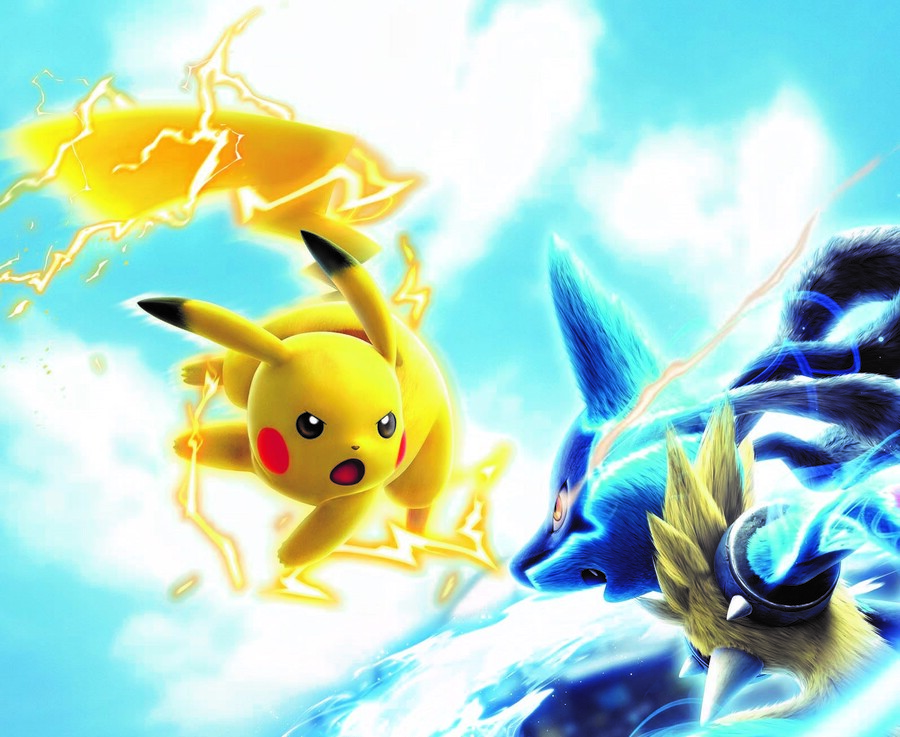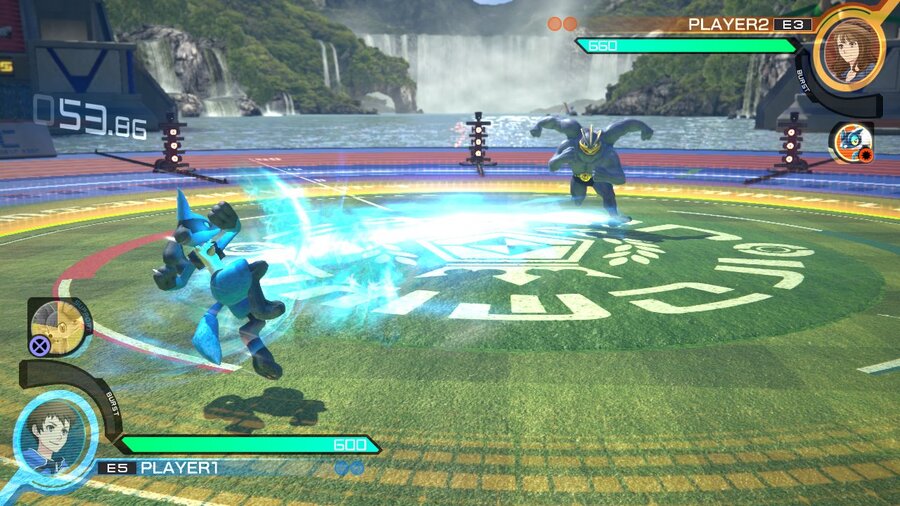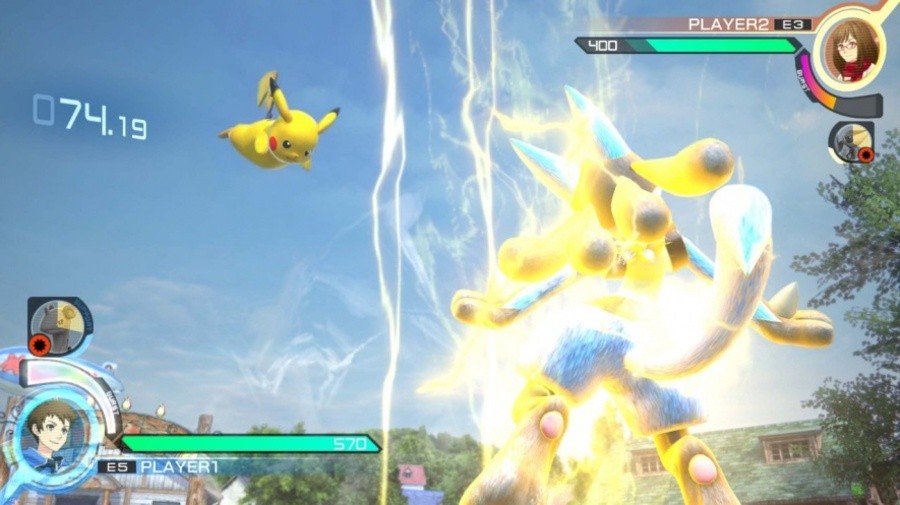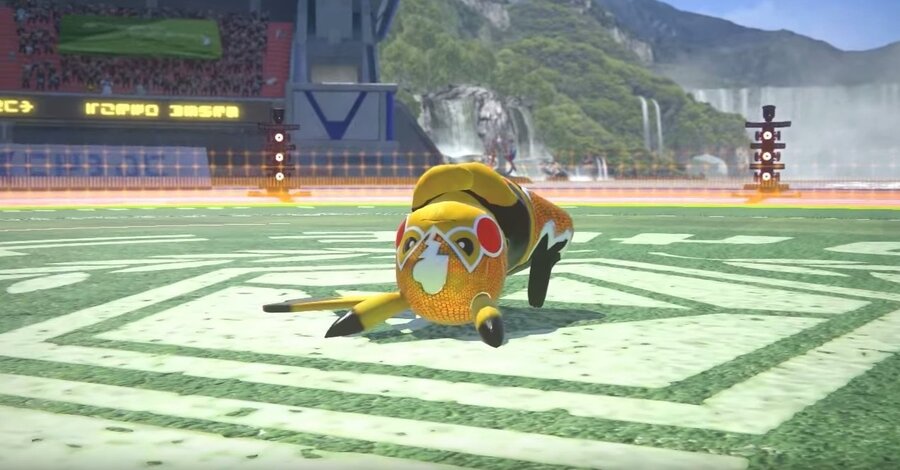
Having been available as an arcade game in Japan for some time, Pokkén Tournament is at last making its way to Western shores on the Wii U. Unlike Super Smash Bros., Nintendo's previous collaboration with Bandai Namco, this title takes a much more traditional approach to the fighting genre. You're tasked with knocking out your opponent before they do the same to you, it's pretty standard stuff. Luckily for fighting game fans that's where a lot of the similarities with series like Street Fighter and Killer Instinct end, and hidden underneath the traditional surface lies a very different experience.
Everything takes place in the Ferrum region, where battles are very different to how Kanto, Johto, and the rest handle things. Your character must 'Synergise' with your chosen Pokémon fighter in order to essentially manipulate their actions like a remote control, but whether this would work in the real world is yet to be confirmed.
The basic combat revolves around three different ways of tackling your enemy: Attacks, Grabs, and Counter Attacks. In a hark back to starter Pokémon these different modes exist in what is known in game as the Combat Triangle, where Attack beats Grab, Grab beats Counter Attack, and Counter Attack beats Attack; learning this rule is absolutely vital if you want to be the very best.
Before we can get into the finer details of the controls we have to mention that every battle takes place in two different phases. The Field Phase allows you to run, jump, and fight freely around the circular or oval battlefield. Once one of the combatants takes a serious hit, both fighters move into the Duel Phase, which functions much more like a typical fighting game. All of a Pokémon's moves can vary between these phases so it's important to be aware when the changes take place, although we've not yet had any issues understanding which phase we were in at any given time.

The basic controls focus around movement with the Left Analogue Stick or the D-Pad, blocking with R, jumping with B, and attacking with Y, X and A. Y is used for ranged attacks in the Field Phase and weak attacks in the Duel Phase; X is used for attacks that home in on your enemy in the Field Phase and strong attacks in the Duel Phase. Regardless of which Phase you're in the A button will always be used for Pokémon Attacks, which are special moves taken directly from the main series. These moves are usually a mix of Grabs, Attacks, and Counter Attacks, but every fighter can Grab or Counter Attack by pressing the Y and B or X and A buttons respectively.
All moves are activated with one of the three attack buttons and a direction on the D-Pad or Analogue Stick. There are no instances of 'rolling' inputs for special attacks like in other fighting games (e.g. Ryu's Hadouken) so learning the controls is much less troublesome for newer players. Due to the way that the game handles we found the D-Pad to be far preferable as there's no analogue input, and the extra precision has saved our skin on more than one occasion.
You're not fighting alone, however, and you'll need to pick one of the fifteen pairs of Support Pokémon to bring into battle alongside your main fighter, and these guys can really aid you when things get heated on the battlefield. In order to use them you must wait for the Support Gauge to be completely filled, which does so over the course of the fight. Certain support Pokémon require a longer charge than others, but these usually result in more powerful bonuses. These helpful critters can aid you in such ways as recovering health, providing temporary attack, defense, or speed boosts, and simply attacking the opponent to name a few. These can really help you get out of a sticky situation or set up the opponent for a brutal combo, so it's definitely a feature you shouldn't overlook.

Alongside your Support Pokémon you also get to choose a Cheer Skill, although for most modes this is handled in your personal options rather than just before a fight. These activate between rounds during a fight (which range in number from one to nine) and can have various effects such as filling your Support Gauge and filling your Synergy Gauge, the latter of which is something you really need to take note of.
The Synergy Gauge fills up when you attack and take damage (in a similar manner to Little Mac's KO Punch from Super Smash Bros.) and once it's full you can activate a Synergy Burst. This is a passive state where your Pokémon has its attack and defence immediately increased as well as recovering a small amount of HP, but that's not nearly as interesting as what else you can do once activated. Once per Burst you can initiate a Burst Attack - although it can be blocked like any other move, should it connect with your opponent they're exposed to a serious world of hurt. The animations are long and for the early part we did find them to be marginally tiresome, but as we got further into the game and came across harder foes pulling these off can become a real challenge, so the animation felt much more like a reward than an intermission.
Mechanically Pokkén Tournament has got everything going for it. The controls are sharp and intuitive, the fighters are diverse and varied, the available options to refine your fighting style are myriad, and the frame rate is utterly untouchable. 60fps is what many would expect from a serious fighting game and Pokkén delivers on this absolutely superbly. We scrubbed through a wide selection of captured footage and weren't able to find a single dropped frame in combat. This is likely thanks in part to the less-than perfect visuals, which whilst are fuzzy and nowhere near as crisp as the arcade, are more than acceptable for the lighting-fast gameplay. It's a trade off for performance over visuals, but we believe it's definitely the right choice.

Naturally there's a local multiplayer mode where one player uses the GamePad and one uses another controller of their choice. This is implemented so that the second screen is used for one player so that they can see things from the perspective that they would expect, rather than reversed and far away in the Field Phase. This is a great idea but unfortunately it results in a massive frame rate drop to just 30fps. This is a disappointment but we can take some solace in the fact that this frame rate, although only half that of the single player, is just as solid and consistent. We can't speak for the online functionality just yet as it's not currently supported, but we'll be sure to keep you informed with how it fares in our review.
On a more superficial note the presentation of Pokkén outside of the battles is absolutely lovely, and calls to mind the Pokémon Stadium games on the N64. You're supported by an advisor who follows you through the entire game providing hints and suggestions, even during battle. As useful as this is in the early game it rapidly becomes nothing more than an irritating string of speeches that you've heard far too many times. Thankfully you can reduce your advisor's speech to nothing more than a text box, which is a blessed relief after listening to her drone on about the same subjects time and time again. You're also given access to an avatar which you can customise with different hairstyles, faces, clothing, and accessories. These start off limited but as you progress you'll unlock new options to provide a whole wealth of different possibilities.
In short Pokkén Tournament is an extremely promising title with bags of potential for friendly and competitive players alike. The pick-up-and-play elements make it very accessible but without losing sight of just how hardcore things are under the surface. It might not be as pretty as the arcade version, but the animations are still smooth, the frame rate is unshakable, and at the end of the day when you're about to get attacked by a Flame Charging Charizard you're not really all that bothered about the detailing on Pikachu's left eyebrow.

Comments 27
So looking forward to this
Can't wait to play this game. Combines my two favourite things: Pokemon and fighting games. March can't come soon enough
I cannot wait for this game. It is seeming like an absolutely incredible game to add to my Wii U game library, and I think my friends and I will have tons of fun battling eachother in this game when we take breaks from our long stretches of playing Smash Bros.
Looking forward to hearing what they do with the soundtrack, good music to fight to is almost as important to me as the gameplay itself for a fighting game.
Does Pikachu have eyebrows?
Glad to know Pokken is shaping up quite nicely. March can't come fast enough! (It's also my birthday month too, so that's a plus.)
I'm not a big fan of watching others play videogames or of fighting games in general but this vid of the finals was pretty interesting. I'm guessing this is the arcade version, but I assume it's close enough for a rough idea of how things work.
https://www.youtube.com/watch?v=JOYhh0thwYY
No mention of the roster? This doesn't bode well.
Still waiting for a review before I take the bait.
It's a missed opportunity for the single player portion of the game to not include an open area to explore in the Ferrum Region with a storyline.
Each day this game sounds better. That 2 phase battle thing could lead to very interesting strategies.
Are all characters available at the start to pick from? (besides Shadow Mewtwo who you can unlock)
DPad use? Then this is better than Smash Bros U. Day one!
With how disappointing most of late 2015 was (Mario Tennis: Ultra Smash, Animal Crossing amiibo Festival, Devil's Third), it's really refreshing to see the quality start they're giving to 2016. Fire Emblem: Fates, Pokkén Tournament, The Legend of Zelda: Twilight Princess HD, Star Fox Zero... my gaming budget is going to run out of money pretty quickly.
@Yorumi
Thanks a lot for sharing. Pretty good video with lots of different Pokemon.
Wow, I was not expecting such a positive review. Although I'm a little confused about the presentation. First the writer says it's wonderful, then she/he says the announcer is terribly annoying. I guess I'm wondering what about about the presentation is great
That announcer lady needs to take better notes from Persona 4 Arena. Both in voice direction and script. .....and timing.
It's not surprising that the technology in the arcade version has better specs than the Wii U!
Anyway, I'm definitely gonna get it! Whether or not I get it as soon as it's released depends on whether I have finished Zelda Twilight Princess HD.
As far as I'm aware pretty much every Burst Attack is completely safe if blocked, and most of them make you invincible when activated, and Gengar's of course can't be blocked at all.
Also, bit disappointed the Wii U version of the game won't look as good as the Arcade version.
Is there something of a single player mode? Perhaps a campaign/story/championship kind of thing? Something for single players to actually "work towards" something?
I'm very interested in this game. But I need something of a story/campaign to work through. If it's just local and online multiplayer, I'll be bored extremely fast.
Anyone know something about this, rumors perhaps?
I have a feeling I know how Alex washes his trainers. He obviously doesn't buy them from Shoe Zone, or they'd fall apart.
I'm a bit concerned about the frame rate on local multiplayer. The fact that it gets cut to 30fps may not seem like a big deal to a lot of people but hitting 60fps is key for having a great feeling fighting game in my opinion.
@Tsurii hahaha, ya know....she has the most bland voice...reminds you of VA from back in the 90s
@Yorumi Thanks!
This could put me over the edge for finally purchasing a Wii-U. I've been waiting for something that felt new, and to finish my backlog from the wii before jumping in (I started the last gen really late).
Plus Pokemon: Type Wild was amazing (the PC free to download pokemon fighting game built as a hobby by the animators of the Pokemon tv series). I've got a feeling some of the people over at gamefreak have been waiting to make a fighter for years....and labors of love tend to be more satisfying.
A wild @Serebii Appeared!
gonna main me?
Nice write-up! I especially loved that final sentence.
I'm not as much of a Pokemon fan anymore, but of all the games ever released, this is one game I actually want to buy.
Show Comments
Leave A Comment
Hold on there, you need to login to post a comment...